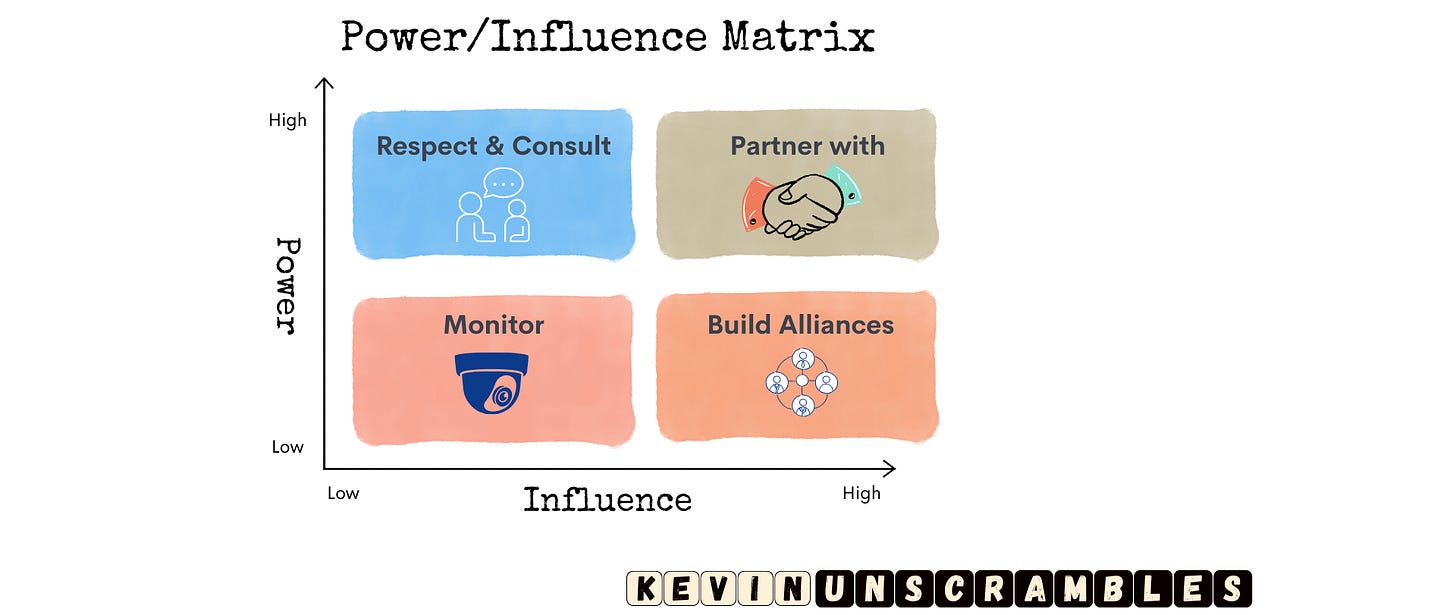There’s a simple reason why even the smartest strategies can struggle or even fail. It is because people forget that change, any kind of change, is normally political.
Whether you’re trying to grow your business, shift direction, take on a leadership role, or roll out something new and important across your team, there is one truth that tends to show up time after time: success rarely hinges on the quality of your ideas alone. Great ideas are necessary but not sufficient. The truth is that success also hinges on how well you understand who holds power and how to go about working with them.
Now I am not making a Machiavellian argument here. Many offices already have a Machiavellian character who ends up doing more damage than good. Instead, I am approaching this topic of power in a more systems-aware way. In business as in politics, ethics matters for long-term success, and long-term success often depends on dealing with the world as you find it.
This is where stakeholder management becomes more than just another corporate buzzword to drop at some point during meetings. It becomes a strategic game-changer that allows you to see the power dynamics at play, which could make or break what you are ultimately seeking to achieve. It’s a skill everybody can learn, sharpen, and apply across any project, role, or career stage, making it a factor that works with them rather than against them.
Behind every great change, every bold pivot, and every business transformation that makes an impact, there’s usually a map. Not just of the marketplace but of the people involved.
Seeing What Others Don’t
Back in the early 1990s, a Professor of Management and Information Systems named Aubrey Mendelow introduced a deceptively simple framework: the Power/Interest Matrix. It has been widely adopted in public sector, nonprofit, and corporate settings, especially in strategic planning and change management.
The idea was straightforward. Plot your stakeholders on a matrix based on how much power they hold and how much interest they have in what you’re doing. Those people with both power and interest? - You should manage them closely. Those with power but low interest? You just keep them satisfied. And so on.
Here’s what it looks like:
Mendelow’s matrix helped leaders assess two key dimensions:
Power: How much formal authority, control over resources, or positional leverage a stakeholder has so that they can get others to do what they want.
Interest: How actively the stakeholder cares about or is engaged with the issue at hand.
That straightforward 2x2 matrix has helped leaders to stop treating everyone the same and start acting more strategically. It clarified where to build alliances, where to avoid surprises, and where to avoid wasting time.
Over time, something interesting happened. As more leaders and consultants started using the matrix in high-stakes projects, they noticed that "interest" alone did not always capture the whole picture. Sometimes, someone who had very little skin in the game on an issue still had a lot of sway over how others responded to it.
That’s when a second version of the matrix started gaining traction: the Power/Influence Matrix.
This time, instead of tracking interest, it looked at how much a stakeholder could influence outcomes through networks, credibility, soft power, or informal authority. While interest is about motivation, influence is about who can sway outcomes, whether they care or not, so the quadrant prescriptions shift slightly. This version was picked up and refined by key strategy thinkers in the late 90s, and then later adopted by key project management organisations.
Both versions are now widely used across government, business, and consulting circles. Each matrix gives you a different strategic lens. And once you know how to use them, you’ll start seeing the world differently as the power dynamics at play in your area become more known to you.
More Than a Framework—It’s a Map of Reality
In any business context, especially if you are managing teams or driving growth, you’re going to be surrounded by stakeholders. Not just shareholders and customers, but employees, regulators, internal influencers, gatekeepers, and informal allies.
Some of these people have decision-making power. Others shape the mood, the narrative, or the cultural momentum. Many of these are colleagues but will not be found on the business org chart, but still, they shape what gets traction and what doesn’t. So, they matter.
If you don’t know who they are or how they’re likely to react, you’re flying blind. If you haven’t mapped their level of power, their influence, and their alignment, you’re pushing forward on unstable ground with resistance hiding in plain sight. But it doesn’t have to be this way.
That’s what these matrices give you: a fast, focused way to map the real landscape, so you can lead with more clarity and reduce unnecessary disruption caused by the unknown.
Stakeholders Are Systems
What makes stakeholder management really powerful, especially for business leaders, is that it doesn’t just help you communicate better. It helps you see the organisation you operate in as a system.
If you think about it, every decision you make triggers a ripple. If you introduce a new business policy, it affects employees, which in turn can affect their morale, which then affects the customer experience, for better or worse. When you launch a new product, you’ve just shifted the priorities and incentives for competitors, regulators, and maybe even your supply chain.
This is a classic case of political economy in action—how systems of power, access, and interest shape what gets done and what doesn’t. Every stakeholder you engage with brings their own system of beliefs, incentives, and power relations. That’s why mapping your stakeholders goes beyond just engagement or communication; it’s about spotting pressure points, understanding feedback loops, and navigating the systemic friction that can either block or accelerate change.
And if you’re leading change, any kind of change, knowing this is going to give you an edge.
More often than not, resistance is not personal; it is patterned. It is not necessary to keep pushing up that hill to force change through brute effort. Instead, it makes more sense to start spotting leverage and using it to shape momentum, not just manage resistance.
So What Does This Look Like in Practice?
Let’s say you’re introducing a change in direction, launching a new product, or proposing something ambitious in the way your team collaborates. First, you would sit down and ask: What’s actually changing here? Who will be affected? Who stands to gain? Who might feel threatened?
You start coming up with names. Not just the obvious ones. You look for decision-makers, influencers, blockers, allies, and skeptics. People who hold power formally and informally.
Then you sketch it out. Who has power? Who has influence? Where are the clusters? Where are the gaps? Who’s deeply invested—and who’s just quietly watching from the fence?
And once you see the shape of the system you are in, the way forward begins to clarify itself. At this point, you have a better sense of who to bring in early. Who should be kept close? Who in the group needs reassurance? And who needs added momentum?
Now, this doesn’t necessarily mean that everyone says yes. But for you, it means fewer surprises, and with more knowledge and control, more stable and responsible outcomes in the future.
Why Stakeholder Mapping Can’t Be an Optional Extra
The pace of business today is relentless and anything but simple. Whether you’re mid-career, in middle management, or running a business, you’re most probably navigating hybrid teams, tighter margins, faster product cycles, and cross-functional demands.
In this complex environment, stakeholder mapping isn’t just a helpful tool; it’s essential. It gives you the language and structure to handle complexity without getting stuck. It helps you move faster because you’ve already thought through the landscape. It builds resilience into your plans by spotting pressure points early. Most importantly, it ensures you focus your energy where it matters most, because not all stakeholders are created equal.
Winning Through Power and Influence
At the end of the day, the Power/Interest and Power/Influence matrices won’t do the work for you. But they’ll show you where the work needs to happen, and where it doesn’t. And in a system shaped by relationships, interests, and influence, that’s really half the battle.
The people who quietly move up the ranks in organisations aren’t just good at their jobs. They’re also good at reading the room, aligning interests, and managing power dynamics. They don’t just have great ideas; they also know how to land them. Those who do it best are pursuing a win-win situation.
And that’s what stakeholder mapping helps you to do.
So next time you’re pushing for change, don’t just build a plan. Build a map.
Because if you can see the system, you can then start to shape your way through it and even change it.





